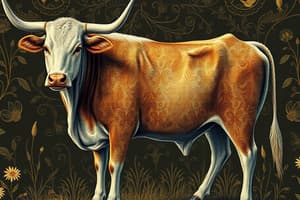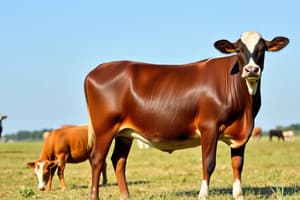Podcast
Questions and Answers
Which phylum do most agricultural animals belong to?
Which phylum do most agricultural animals belong to?
- Echinodermata
- Arthropoda
- Chordata (correct)
- Mollusca
What is the primary classification category that contains horses, cattle, and pigs?
What is the primary classification category that contains horses, cattle, and pigs?
- Class (correct)
- Family
- Order
- Phylum
What subphyla are agricultural animals primarily found in?
What subphyla are agricultural animals primarily found in?
- Crustacea
- Invertebrata
- Vertebrata (correct)
- Cephalopoda
Which of the following orders does not fall under the class Mammalia?
Which of the following orders does not fall under the class Mammalia?
Which statement accurately defines the final categories in the scientific classification system?
Which statement accurately defines the final categories in the scientific classification system?
Which of the following farm animals have a four-chambered stomach?
Which of the following farm animals have a four-chambered stomach?
What is the primary role of saliva in mature ruminants?
What is the primary role of saliva in mature ruminants?
Which part of the ruminant stomach is primarily responsible for fermentation?
Which part of the ruminant stomach is primarily responsible for fermentation?
What distinguishes non-ruminant herbivores from ruminants?
What distinguishes non-ruminant herbivores from ruminants?
What percentage of saliva secretion comes from the parotid gland in ruminants?
What percentage of saliva secretion comes from the parotid gland in ruminants?
Which of the following is a characteristic of the prehension process in ruminants?
Which of the following is a characteristic of the prehension process in ruminants?
Which type of digestive system contains only one stomach and cannot digest complex food substances?
Which type of digestive system contains only one stomach and cannot digest complex food substances?
How many times per day must herbivores typically chew their food?
How many times per day must herbivores typically chew their food?
What is the primary function of microorganisms in the rumen?
What is the primary function of microorganisms in the rumen?
Which part of the stomach serves to eliminate excess water from feed?
Which part of the stomach serves to eliminate excess water from feed?
What is the primary secretion produced by the fundic glands?
What is the primary secretion produced by the fundic glands?
How often do contractions in the rumen occur?
How often do contractions in the rumen occur?
What role does mucus play in the stomach?
What role does mucus play in the stomach?
What is the maximum rumen capacity of a 1000 lb cow?
What is the maximum rumen capacity of a 1000 lb cow?
Which function is performed by the reticulum?
Which function is performed by the reticulum?
What is the function of hydrochloric acid (HCl) in the stomach?
What is the function of hydrochloric acid (HCl) in the stomach?
What does the term 'purebred' refer to in animal classification?
What does the term 'purebred' refer to in animal classification?
Which class do all the listed agricultural animals belong to?
Which class do all the listed agricultural animals belong to?
What is a characteristic of ruminant animals?
What is a characteristic of ruminant animals?
What is selective breeding?
What is selective breeding?
Which of the following is NOT a classification of farm animals based on their digestive system?
Which of the following is NOT a classification of farm animals based on their digestive system?
Which family do cattle, buffalo, sheep, and goats belong to?
Which family do cattle, buffalo, sheep, and goats belong to?
What is the purpose of a breeding association?
What is the purpose of a breeding association?
Which genus does sheep belong to?
Which genus does sheep belong to?
Flashcards are hidden until you start studying
Study Notes
Classification of Agricultural Animals
- Agricultural animals belong to the kingdom Animalia, specifically the phylum Chordata.
- Chordata is further divided into subphyla, Vertebrata being the most relevant for agricultural animals.
- Vertebrata, animals with backbones, is further divided into classes, with agricultural animals such as horses, cattle, goats, sheep, and pigs belonging to the class Mammalia.
- Classes are divided into orders, which group animals within a class based on shared characteristics.
- The order Artiodactyla, which includes cows, goats, sheep, and pigs, is a part of the class Mammalia.
- Artiodactyla has three suborders: Ruminantia.
- Families are a further subdivision of orders, followed by genus and species, which are also an animal's scientific name.
Classification of Breeds
- A breed is a group of animals with a common origin and characteristics.
- Selective breeding involves choosing the best animals for breeding purposes.
- Purebred animals are those whose ancestors are of only one breed, while a crossbreed is an animal with parents from two different breeds.
- Breeding Associations promote specific animal breeds and regulate the registration process of purebreds.
- Sometimes, species can be successfully crossed to produce new breeds.
- Dual purpose animals are raised for more than one purpose, such as milk and meat production.
Classifications of Farm Animals
- Farm animals are domesticated and reared for various purposes, including meat, eggs, milk, and other products.
- Farm animals are classified based on their digestive systems.
Ruminant/Poly-Gastric Animals
- These animals have four-chambered stomachs.
- They are able to digest complex carbohydrates like cellulose, feeding on grasses, legumes, shrubs and herbs.
- Ruminant animals, including sheep, cattle, goats, deer, and giraffes, can regurgitate uncompleted chewed food for further chewing, a process called Rumination.
Non-Ruminants (Monogastric)
- These animals have one simple stomach.
- They cannot digest complex food substances and rely on concentrates.
- Examples include poultry and pigs.
Non-Ruminant Herbivores
- These animals have a simple stomach and a large cecum, allowing them to digest certain food substances with the help of microorganisms.
- Examples include rabbits and guinea pigs.
The Ruminant Digestive System
- The rumen is a large, anaerobic fermentation vat that harbors microorganisms and helps digest roughages.
- The reticulum is commonly called the hardware stomach.
- The omasum eliminates excess water from feed.
- The abomasum is the true stomach where gastric juices and enzymes are secreted.
Digestion in the Mouth
- Prehension is the process of bringing food to the mouth, with different mechanisms used by various animals based on their behavior and diet.
- Mastication is the chewing process that crushes food, increasing surface area for enzyme action.
- Herbivores chew continuously to increase surface area for efficient digestion.
Ruminant Mouth - Teeth
- Teeth function to reduce particle size.
- This structure is composed of upper dental pads, lower incisors, premolars, and molars.
Saliva
- Saliva is secreted from several glands and helps in mastication, swallowing, and bolus formation.
- While mature ruminant saliva does not contain digestive enzymes, it provides nutrients and buffering compounds for rumen microorganisms.
Salivation
- The quantity and composition of saliva vary significantly between species.
- The amount secreted is related to the level of chewing activity.
Stomach Regions
- The stomach is divided into several regions:
- Esophageal: non-glandular.
- Cardiac: secretes mucus.
- Fundic: contains parietal and chief cells.
- Pyloric: secretes mucus.
Gastric Glands
- Gland types include:
- Cardia: mucous secretion.
- Pylorus or Antrum: mucous secretion.
- Fundus:
- Chief cells: enzyme secretion (pepsinogen).
- Parietal cells: acid secretion (HCl).
Stomach Secretions
- The stomach secretes hydrochloric acid (HCl), pepsinogen, mucus, rennin (in some species), and lipase.
- HCl decreases pH, denatures protein, kills bacteria, and activates pepsinogen.
- Pepsinogen is activated to pepsin, which hydrolyzes protein.
- Mucus protects the stomach lining and acts as a lubricant.
- Rennin, present in the abomasum, clots milk.
- Lipase plays a role in fat digestion.
Studying That Suits You
Use AI to generate personalized quizzes and flashcards to suit your learning preferences.




